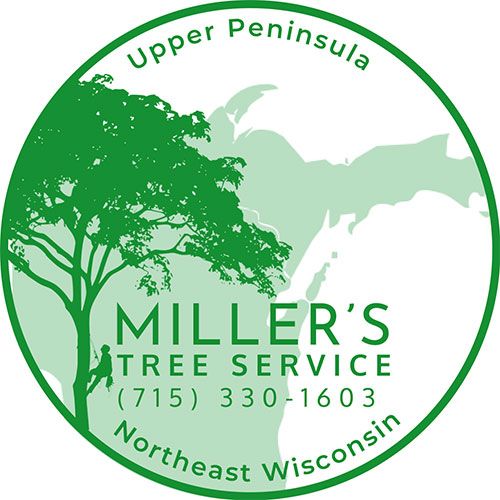Serving Northeastern Wisconsin and the Upper Peninsula
Resources
Miller's Tree Service
The Emerald Ash Borer (EAB)
Tiny Insect, Big Problems
Emerald ash borer (EAB) is an invasive species that is extremely destructive to all species of ash trees in Michigan and Wisconsin. The EAB larvae destroys the vascular system of the tree, cutting off the nutrient supply leading to the death of the tree. Since ash trees don’t have a natural defense system to protect itself against these attacks these trees will decline and die in a matter of a few years or less. Where beetle populations are high, trees can die within just one single year of infestation. The beetle’s rapid spread and extensive damage it causes have made it one of the most destructive forest pests in North America. Early detection and effective management are critical in combating this invasive species and protecting ash populations.
Circle of Life
- Adult female ash borer lay eggs in bark crevices or under bark flaps, the eggs will hatch in under two weeks.
- Larvae burrow under the bark and feed on the cambium, creating the S-shaped winding galleries disrupting the nutrient flow.
- They will feed all winter beneath the bark and the next spring/ early summer start to transformation into beetles.
- Adult beetles emerge through D-shaped exit holes in the bark and are active for roughly 3-6 weeks. During this time they will mate and females will lay eggs to restart the cycle.
Are My Trees Safe?
While EAB only attacks the ash species, that is good news for other native trees here, but as for our ash tree population that is devastating news. Michigan/ Wisconsin is home to three native ash species, black ash, green ash, and white ash, totals have been estimated to be one billion total ash trees. EAB does not attack any other tree species and will not spread from an ash tree to an oak, maple, birch, etc. Preventive treatment can be done to save your ash trees, but typically by the time signs are noticed it is too late for treatment options.
Signs of Emerald Ash Borers
- Tree canopy dieback, thinning working downwards
- D-shaped exit holes for adult emerald ash borer beetles
- Woodpecker feeding looking for larvae, blonde bark
- S-shaped larvae galleries under the bark
- Vertical bark splitting exposing the galleries
- Premature leaf dropping falling early than usual
- Epicormic shoots, sucker limbs
- Cracked, weak, dead branches
Treatment & Preventative Measures
As of now there are only two options available to fight against the emerald ash borer.
- A yearly soil-applied systemic treatment
- A bi-yearly trunk injection systemic treatment
serving
Menominee County, MI
Marinette County, WI
Brown County, WI
Business Hours
- Mon - Fri
- -
- Saturday
- -
- Sunday
- Closed
24-Hour Emergency Tree Services Available

Share On: